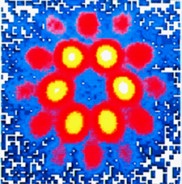Flux Lattice in Superconductors and
Melting
When a small magnetic field is
applied to a superconductor, internal "supercurrents" are generated
that completely expel the field, which is known as the Meissner effect. At
higher applied fields most superconductors (called type-II) allow the
field to penetrate, but the magnetic flux is quantized into tubes called
vortices. When vortices are present, however, a superconductor isn't
really superconducting, because the vortices move in the field and moving vortices create resistance to a current
flow. In this vortex state zero resistance only occurs when the material has enough flaws to "pin" the
vortices in place, forming a well defined vortex lattice as shown in the figure
below. This lattice is two-dimensional in nature, and in two dimensions
true long range structural order cannot exist. Hence the nature of the
vortex lattice in superconductors, and the subtle role that pinning plays in the
properties of superconductors, has been a topic of interest for decades. We
have carried out small angle neutron scattering (SANS) measurements on the vortex
lattice in the cuprate superconductor
YBa2Cu3O7 (references below), as well as on the high
quality prototypical elemental system of niobium that we now discuss.
As a superconductor is warmed, its critical current drops, but
over a narrow range of temperatures the critical current suddenly increases and then decreases again. This "peak effect" is thought to be caused by a "softening" of the warming vortex lattice--with a Jell-O-like consistency, vortices can more easily find pinning sites (defects) in the atomic lattice, which briefly allows more supercurrent to flow.
Our early data suggested that there was a melting transition to a "vortex liquid" in high temperature
superconductors, but it's possible relation to the peak effect was
unknown. A critical aspect was the subsequent inclusion of in-situ susceptibility
measurements concurrent with the SANS measurements, which established that the
peak effect was associated with a real melting transition to a "vortex liquid".
Inclined-field
Structure, Morphology and Pinning of the Vortex Lattice in Microtwinned YBa2Cu3O7
Observed by Neutron Scattering, B. Keimer, I. Aksay, F. Dogan, R. W.
Erwin, J. W. Lynn, and M. Sarikaya, Science
262, 83 (1993).
Vortex
Dynamics and Melting in Niobium, J. W. Lynn, N. Rosov, T. Grigereit, H.
Zhang, and T. W. Clinton, Phys. Rev. Lett.
72, 3413 (1994).
Neutron
Scattering Studies of the Vortex Lattice in Niobium and 123 Superconductors, N.
Rosov, J. W. Lynn, and T. Grigereit,
J. Appl. Phys. 76, 6772
(1994).
Reply to "Comment on Vortex Dynamics and Melting in Niobium", J. W.
Lynn, N. Rosov, T. Grigereit, H. Zhang, and T. W. Clinton, Phys. Rev.
Lett.
74, 1698 (1995).
Vortex
Structures in YBa2Cu3O7, B. Keimer, J. W.
Lynn, R. W. Erwin, F. Dogan, W. Y. Shih, and I. A. Aksay, J.
Appl. Phys.
76, 6778 (1994).
Vortex
Lattice Symmetry and Electronic Structure in YBa2Cu3O7, B. Keimer, W. Y. Shih, R. W. Erwin, J. W. Lynn, F. Dogan, and I. A.
Aksay, Phys. Rev. Lett.
73, 3459 (1994).
Reply
to `Comment on `Vortex Lattice Symmetry and Electronic Structure in YBa2Cu3O7',
B. Keimer, W. Y. Shih and J. W. Lynn, Phys. Rev. Lett. 75, 1423,
(1995).
Vortex
Dynamics and Melting in Niobium, J. W. Lynn, N. Rosov, and T. E. Grigereit,
J. Mag. Mag. Matr. 140-144, 2067 (1995).
Superheating and Supercooling of Vortex Matter in a Nb Single Crystal:
Direct Evidence for a Phase Transition at the Peak Effect using Neutron
Diffraction, X. S. Ling, S. R. Park, B. A. McClain, S. M. Choi, D. C.
Dender, and J. W. Lynn, Phys. Rev. Lett.
86,
712 (2001).
Reply
to Comment on "Direct Observation of Superheating and Supercooling of Vortex
Matter using Neutron Diffraction", X. S. Ling, S. R. Park, S. M. Choi,
D. C. Dender, and J. W. Lynn, Phys. Rev. Lett. 89, 259702 (2002).
Fate
of the Peak Effect in a Type-II Superconductor: Multicriticality in a Bragg Glass, S. R. Park, S. M. Choi,
D. C. Dender, J. W. Lynn, and X. S. Ling,
Phys. Rev. Lett. 91,
167003 (2003)
.
Peak Effect in Polycrystalline Vortex Matter, I. K. Dimitrov, N. D.
Daniilidis, C. Elbaum, J. W. Lynn, and X. S. Ling,
Phys. Rev. Lett. 99,
047001 (2007).
Emergence
of Quasi-Long-Range Order in a Crystallizing Vortex Lattice, N. D. Daniilidis, S. R. Park, I. K. Dimitrov, J. W. Lynn, and X. S. Ling,
Phys. Rev. Lett. 99,
147007 (2007).
 Recent Publications
Return
to main page
Recent Publications
Return
to main page

